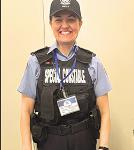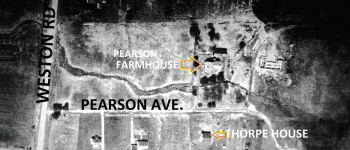
As demand for the building of new houses continues to rise in Toronto, many are unaware that there once existed a time when housing shortages reached epidemic proportions throughout the entire city.
This occurred at the end of the second world war when military veterans were returning home with hopes and dreams of finding new beginnings. The City of Toronto sent stern messages to all would-be home buyers that there was no housing available for any new families requiring accommodation. A 1944 paid advertisement in the Toronto Telegram newspaper reinforced the municipality’s harsh message to the public. To help address the country’s housing shortage, legislation known as the Veterans Land Act (VLA) set the wheels in motion and helped launch many new neighbourhood developments.
On the east side of Weston Road, there existed a working farm about 800 metres south of Finch Avenue. The farmhouse and barn were owned and operated by the Pearson family and sat on the north side of modern-day Damask Avenue. In 1948, several new families approached Pearson about building houses on the south side of the driveway leading into his farm. The families intended to take advantage of the existing government program to build their own homes. 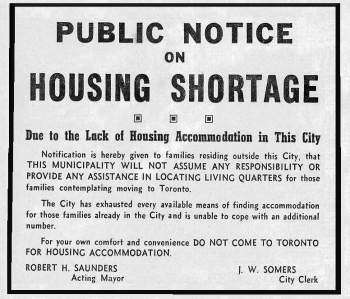
Under the legislation of the Veterans’ Land Act of 1942 (VLA), Len and Veronica Thorpe purchased two and a quarter acres and built a home on the south side of the Pearson laneway.
In 1949, construction began for four separate houses along Pearson’s driveway. It formally became known as Pearson Avenue. To help identify the entry point of the new street, two stone pillars and several trees were erected on either side of the new entrance off Weston Road. Throughout the construction phase, the Pearson farmhouse and barn continued to function normally on the north side of the 100 metre long driveway.
The Thorpes were residing in Pine Grove near Woodbridge and Len worked at the plant ES&A Robinson. He later transferred to Canadian Gypsum on Oak Street in the old Town of Weston.
In September 1949, the Thorpes moved into their newly built home along Pearson Avenue with their four year old son, Tim. Another young boy moved into a house on the laneway who would become Tim’s friend. His name was Bruce Wallace and his father worked as a barber at Dufferin and Eglinton. Pearson Avenue would see the names of Turner, Wallace, Thorpe and Brown building new homes on the south side of the new street.
In 1951, six year old Tim Thorpe began attending the Emery Public School located on the north-east corner of Finch and Weston Road.
Two of Thorpe’s classmates included farm kids, Jim Castator and Keith Cadeau. His first teacher was Mrs. L.E. Ware who taught classes in a portable. Grades for following years were taught by Mr. G.T. Woodward and by Mr. Walter Ferris, the school’s principal.

For most, there were pleasant memories connected with Mr. Ferris. However, there were also a few unpleasant ones.
The unruly and hardened nature of the community’s farm children was sometimes visibly challenging for Mr. Ferris. In one famed incident, Thorpe became the last student to ring Emery’s school bell when he tugged it so hard that he yanked the rope right off the bell. This was one of the times that Mr. Ferris was required to administer the strap for disciplinary reasons.
Students’ oral health care was attended to at the school in late spring. A dentist would arrive in a car while pulling a trailer. The trailer was used as an office where a hand operated drill was used to give children fillings. The customs of Halloween in rural Emery were pretty much the same as they are today. Tim Thorpe would venture over to the farmhouses along Weston Road and receive special treats from nearby neighbours Charlie Grubbe and Jethro Crang.
Thorpe also has vivid memories of Remembrance Day ceremonies that were conducted at Emery’s Cenotaph, right in front of the school. For recreation, Thorpe would hang out near the base of the Emery Creek near a bridge and driveway leading to Richard Storer’s commercial property and farmhouse. The adjacent forest along Weston Road was nicknamed, “Paradise Island” by local children. This is where they caught an abundance of garter snakes, crayfish and fish before cooking them up for their own private outdoor feast.
Thorpe’s favourite memory of his childhood comes from 1959, when he received his first brand new blue racing bike with three separate gears and a shifter.
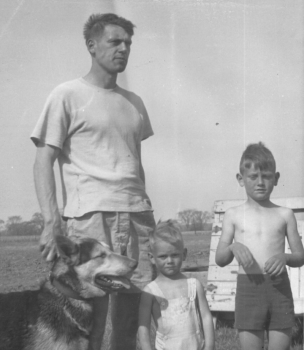
His most horrible experience happened in October 1954 when he was just nine years old. This is when the Thorpe family lived through the battering and torrential downfall of Hurricane Hazel. Weston Road became so flooded with rainwater it blocked the route travelling north to the school. Just two years later, a wave of modern subdivision building finally reached the outskirts of rural Emery. A new housing development was built called Woodview Park. The subdivision featured many new semi-detached houses all around Pearson Avenue and completely eliminated the existing farm.
By early 1957, the Pearson farmhouse and barn were leveled and new streets appeared named Habitant, Imogene, Fernando, Calm Court, Stone Court and Rivalda. The Brown’s house was put on a flatbed and relocated to Weston Road near Sheppard. The other original homes along Pearson Avenue would see their boundaries modified slightly to allow additional homes on the street that had completely different property lines. It was at this time that Pearson Avenue became Damask Avenue.
In the summer of 1960, Mark and Tim Thorpe had the unique experience to walk around a massive hole on the former farm of neighbours Dick and Mary Veerbeek. The hole was created to construct Emery Collegiate’s new swimming pool. Thorpe would attend Emery Collegiate Institute in 1961 for his final year of local schooling. He had the distinction to attend Emery’s newly built high school in its first year of operation.
The following year, he completed his high school education at Western Technical Commercial School near Bloor and Runnymede.
Tim Thorpe is now retired from his previous career position with a regional municipality.
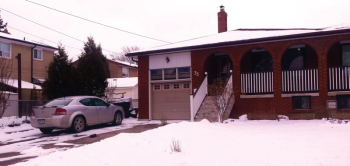
The countryside setting of the Thorpe home in Emery allowed him to be brought up in completely rural surroundings. This was followed by a swift transformation into an urban neighbourhood, in just a few short years. This is an experience that very few people ever have an opportunity to live through.
The home that Len Thorpe built at 31 Damask Avenue has now been replaced with a semi-detached building with two separate connecting houses. And, the Thorpes’ original two and a quarter acre property lines are no longer the same as they were in 1949. But one thing has gone full circle. Today, some people might think it is purely a modern concept that envisions the building of new homes in available laneways. But indeed this concept had its own roots from Emery’s rural past.


